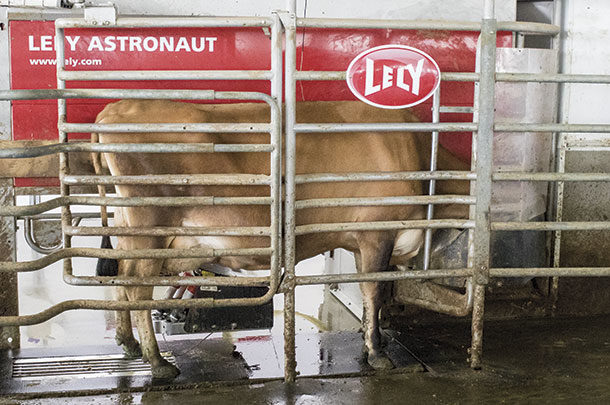Two Canadian dairymen, Todd Holm from Ontario and Stefan Signer from Manitoba, were joined by Josh Gamble of Indiana on the panel that discussed feed management in robot barns.
How many pounds of pellets?
All three dairymen feed a pellet through the robot, but at varying levels. In Gamble’s four-robot barn, the high-producing cows are fed 10.9 kilograms (24 pounds) of pellets per day, while Holm dispenses 6.5 kilograms (14.3 pounds) of pellets to this group. Signer feeds 9 kilograms (19.8 pounds) of pellet and cows receive one of two fat supplements based on their milk production level. Cows are pastured when grass is available as an inexpensive supplement. “It doesn’t cost me anything to have that cow walk outside and eat grass,” Signer said.
Feeding corn through the robot
Gamble’s 240-cow herd receives ground high-moisture corn through the robots. He opted not to pelletize the feed to avoid an additional cost of $18 per ton. “The corn is pretty fine, like pig feed, and consistent,” he said. They are eating around 2 kilograms (4.5 pounds) of it mixed with corn husks and a bakery byproduct, which the cows find quite palatable. “They eat it all up,” he added.
Signer has also experimented with homegrown corn options. “I believe cows eat high-moisture corn faster than dry corn, and they do like it more,” he said. “I have ran dry corn through the same system and visits are the same, but it doesn’t get cleaned up in the bowls.”
However, he acknowledged it’s a challenge to keep corn fresh in the robot. “Feeding high-moisture corn is more work,” he said. “If things aren’t clean, yesterday’s corn turns all kinds of colours.” To prevent spoilage, a big hopper box with two augers at the bottom holds a day’s worth of corn.
Feeding fresh cows
Each dairy takes a slightly different approach to how they feed cows post-calving. Holm provides a fresh cow ration and partial mixed ration (PMR) that is very similar to the lactating cow ration. On Gamble’s dairy, the protocol is to keep cows in a separate bedded pack area for the first week to 10 days after calving where they are fetched for milking three times a day. The TMR is top-dressed with a rumen-protected choline supplement.
Signer focuses on ramping up cows quickly by supplementing fresh cows with an energy booster to increase body condition. He uses a scale to monitor weight changes in this group. He has been successful in keeping cows healthy during this critical phase by offering hay. “I always keep a bale of nice, grassy mix hay at the end of the bunk for free choice,” he said. “If cows are feeling iffy, that gets fibre in the rumen.” This trick has minimized the incidence of displaced abomasums in his herd.
Robotic feed delivery
At Holmdale Farms Ltd., all cows have access to both a TMR and PMR, fed and delivered robotically. Holm said investing in a Vector feeding robot was a “no brainer” because the cost of the unit was the same as replacing a tractor and mixer. “The capital cost of equipment was almost the same,” he noted, mentioning saved time was an added bonus. “It takes just 10 minutes of clean up.”
Without the need to mix and deliver feed manually, Holm sees the benefits to both herd management and quality of life. He is better able to observe the cows’ eating behaviour. “I see cows eating more between 4 to 7 p.m.,” he said. He now also has the ability to step away from the robot and let it go to work so he can enjoy holidays. “Over Christmas, we can fill our kitchen for five days, as long as we don’t have any alarms,” he said.
Advice for other dairy producers
The panelists reflected on their experiences to offer advice to other dairy producers considering robotic systems. “Plan, plan, plan,” Gamble suggested.
Signer urged producers to keep the feeding strategy simple during the start-up phase. “One of the pitfalls is wanting to get too complicated too quickly,” he said. “Start with an off-the-shelf pellet from the nutritionist for the first three to six months; then try working with commodity feeds or homegrown grains.”
Holm commented on the benefits of the robotic farming style once the system is up and running. “I have the freedom of managing cows without being locked in a parlour or feed truck, so I can spend more time with cows or picking herd sires,” he said.
Further noting improvements from his experience, Holm concluded, “Expect 10 percent more milk and a better quality of life.” ![]()

-
Peggy Coffeen
- Editor
- Progressive Dairyman
- Email Peggy Coffeen
PHOTO: Photo by Mike Dixon.










